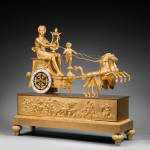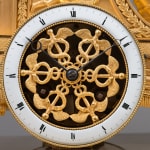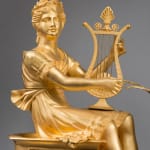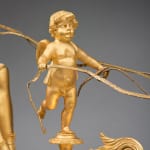Jean-Simon Deverberie (attributed to) 1864-1824
Further images
Literature
Jean-Dominique Augarde, “Les Ouvriers du Temps”, 1996, p. 143, pl. 106, illustrating a similar clock by Deverberie, signed on the dial Inv. Et fait par Deverberie rue Barbet au Marais, Paris, with an infant Mercury rather than Cupid, noted as from Galerie Gismondi, Paris.
Elke Niehüser, “Die Französische Bronzeuhr”, 1997, p. 243, pl. 914, illustrating a similar clock to the latter.
Pierre Kjellberg, “Encyclopédie de la Pendule Française du Moyen Age au XXe Siècle”, 1997, p. 416, pl. A, illustrating the same clock as that appearing in Augarde, op. cit. And p. 416, pl. B, illustrating an unsigned chariot clock with figure of Cupid driving a dragon-shaped chariot pulled by very similar horses to the present pair and featuring an identical frieze on its base.
Charlotte Vignon, “Deverberie & Cie: Drawings, Models, and Works in Bronze”, in “Cleveland Studies in the History of Art”, vol. 8, 2003, p. 186, listing clocks by Jean-Simon Deverberie featuring Apollo riding his chariot.
A magnificent Directoire gilt bronze chariot clock of eight day duration attributed to Jean-Simon Deverberie, the white enamel chapter ring with Arabic numerals and blued steel Breguet hands for the hours and minutes set within the wheel of a chariot which is cast at centre with six caduceus-shaped spokes. The movement with anchor escapement, silk thread suspension, striking on the hour and half hour, with outside count wheel. The beautiful case representing the figure of Apollo seated in his chariot holding a lyre and wearing a laurel leaf crown, Roman sandals and tunic, his golden chariot mounted with a pair of putti above the dial, drapery below, a lion head at the back and at the prow another lion head, upon which stands on one foot the figure of the young winged Cupid who, like Apollo, holds reins attached to a pair of prancing horses that pull the chariot onward, each horse with a flowing mane and tail, wearing a lambrequin saddle cloth, the chariot and horses on a rectangular plinth with a frieze cast representing the Triumph of Apollo showing the mythological Sun god seated in his chariot or quadriga that is drawn across the clouds by four horses, in front of which is Mercury and a winged female figure with basket of fruit while behind the chariot is Clio, Muse of History holding a tablet and a pair of putti, one holding a wreath and horn and the other a mask to symbolise Melpomene, Muse of Tragedy, the base with an egg-and-dart border below, supported on four toupie feet
Paris, date circa 1800
Height 57 cm, length 59 cm, depth 20 cm.
This magnificent chariot clock or pendule au char can be attributed to Jean-Simon Deverberie (1764-1824), owing to its similarity in form and quality to others by this esteemed Parisian maker. Among them is one previously sold by this gallery as well as another illustrated in Augarde and Kjellberg. The main differences being that here the frieze is more elaborate though the clock itself is slightly smaller and at the same time there are variations in the shape and decoration of the chariot, Apollo’s dress and the pose of the two rearing horses.
Charlotte Vignon, from Cleveland Museum of Art, (op. cit. p. 186) notes that a Deverberie clock with Apollo riding his chariot was sold at Galerie Georges Petit in Paris on 5th December 1930, lot 10. Vignon also lists a clock of the same description having been sold at Christie’s New York on 13th June 1987, lot 73 and likewise at Galerie Koller, Zurich on 2nd November 1995, lot 4059. In addition, a clock of a comparable model, again without Deverberie’s signature, made of gilt and patinated bronze and the figure of Mercury instead of Cupid, was sold at Sotheby’s Paris 4th November 2015, lot 426. Despite the signature, it too was described as an important clock while mention was made in the catalogue that a design by Deverberie for the case was housed in the Bibliothèque Institut National d’Histoire de l’Art (INHA), Paris. Deverberie also designed a number of other pendules au char including one with Aphrodite and a pair of winged putti riding a chariot on the sea and another of Hera in her chariot, of which the original designs (illustrated Vignon, op. cit, p. 174, pls. 1.29 & 31, respectively) are now housed in the Bibliothèque INHA. Added to them, Deverberie made other chariot clocks such as one with Victory at the helm, signed on the dial ring Lépine place des Victoire, which was sold at Hôtel George V, Paris, 23rd June 1988, lot 115 as well as others with Cupid in the chariot, of which some were signed with Deverberie’s name while others featured the name of the Parisian clockmakers Armingaud l’aîné and Chopin.
Although the exact date of when Deverberie became a maître bronzier is unrecorded, we know that he was working as a caster in 1788. Charlotte Vignon’s article notes that he may have been the same Deverberie who specialised as a watchcase maker and that after the abolition of the guilds in 1791, he opened a bronze casting and clock factory with Jean George Hertzog. Having been established at rue Barbet au Marais, Deverberie then moved to rue des Fossés du Temple where he ran the firm of Deverberie et Cie. The lifting of the guild regulations during the French Revolution allowed casters, who were strictly limited to working in bronze during the ancient règime, to at last develop factories of their own. Deverberie was one such man who took advantage of this freedom so that now all stages of the bronze making process, from casting, gilding, assembly and retail could occur in one workshop. In this he proved highly successful since by 1803 his business was worth 104,000 francs and the previous year had sent goods worth 40,000 francs to the Leipzig fair.
Deverberie et Cie made a range of luxury bronze objects from chenets and fire grates to candelabra and chandeliers. However, clock cases were his speciality. Not all were fitted with his movements but included those supplied by the Imperial clockmakers Henri Lepaute and Lépine as well as Lemoine, Marc Sandoz, Dubuc (Dubucq) and others. At times Deverberie contracted part of the gilding to Jean Claude Herouard, Jean-Jacques Dubois and others and also bought in glass globe covers for his clock cases from the famous glass blower Jean-Baptiste Binet as well as marble from Gilles l’ainé. Unlike most major bronziers, Deverberie did not supply the Garde-Meuble direct though he may have done so through as intermediary. Rather he tended to cater for a private clientele; he also sold his cases to other European clockmakers while others were destined for the Russian and Turkish export market.
Whilst Deverberie’s chariot clocks continue to be among his most prized pieces, he is probably better known for his series of clock cases, known as pendules au nègre or pendules au bon sauvage, notably those portraying female personification of Africa or America, which as a subject epitomised late eighteenth century European society’s fascination with the exotic, unadulterated and untamed natural world. As such they could be seen as representing a new mythological Golden Age as opposed to chariot clocks, which focused upon the mythology of the ancient classical world. As such, Apollo – one of the twelve Olympian deities, was perfectly suited for such clocks since he also became associated with the sun-god Helios who daily drove his chariot across the skies. As here, Apollo was generally portrayed as a beautiful young man who wears a crown of laurel leaves which he was awarded for his achievements to the arts. He also holds a lyre, alluding to him being a patron of poetry, music and as a leader of the Muses.







